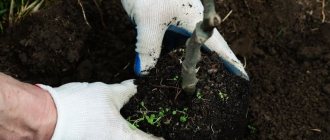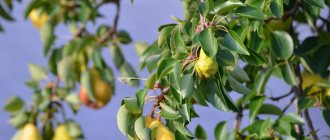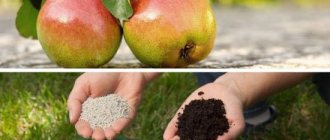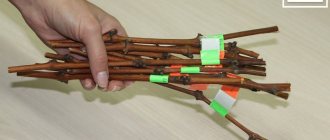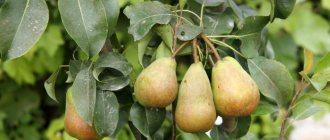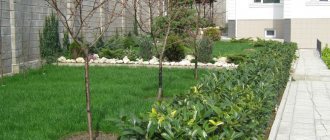Is it possible to propagate pears from cuttings?
Most often, gardeners propagate varietal pears by grafting cuttings or eyes. If the rootstock and scion are poorly compatible, seedlings with low frost resistance and poor immunity are obtained. The yield is worse and does not correspond to the declared one.
The problem can be solved by growing own-rooted pear seedlings from cuttings. Advantages of own-rooted pear:
- durability;
- the tree recovers well from the root shoots when the above-ground part is damaged;
- high winter hardiness;
- preservation of all varietal characteristics of the pear.
Planting and rooting
Inexperienced gardeners at first doubt whether it is possible to grow a pear from a cutting, but after trying this method, they are deeply convinced that it is possible! The main thing is to carry out planting and subsequent rooting correctly. For seedlings, it is recommended to select a box whose height is 25-30 cm. Its lower part, approximately 15 cm, is completely filled with black soil, supplemented with organic components and well moistened. Everything is sprinkled with a thin layer of sand on top. Previously prepared cuttings are immersed in the resulting soil only a few centimeters - 1.5-2, no more.
If you plant them too deep, the branches may begin to rot. It is important to maintain a distance between the cuttings so that their leaves do not touch each other or come into contact with the walls of the container. They need greenhouse conditions, which are created in a fairly simple way - by wrapping the box in film. Initial care should consist of:
- providing diffuse lighting;
- maintaining fairly high humidity in the room through frequent use of a water spray;
- regular spraying of plants (jet watering is excluded, as compaction or destruction of the top layer of soil may occur);
- systematic ventilation of the mini-greenhouse (once a week will be enough).
From time to time it is necessary to inspect the leaves of the cuttings for damage or symptoms of rotting. If defects are noticeable, the diseased parts of the branches are immediately cut off. In some cases, it is better to discard the entire cutting to prevent it from harming others. Provided the seedlings are properly cared for, they will begin to produce their first roots within 4-5 weeks, signaling that they need more frequent ventilation.
In this way, the cuttings are hardened, gain strength, and in the fall, without replanting, they are immersed in the soil in the fresh air. They are buried so that the top layer of soil contained in the box is equal to the ground level. In this case, it is advisable to take insulation measures - cover the surface with a thin layer of sawdust. If the seedlings overwinter successfully, in the spring they can be moved to a completely open area, and later to a full-fledged habitat.
Varieties suitable for growing pears from cuttings
Pear varieties differ in their ability to propagate by cuttings. Rooting, in addition to varietal characteristics, is influenced by many factors:
- age of the tree;
- escape power;
- timing of cuttings;
- quality of root formation stimulator.
The percentage of rooting of cuttings is higher in small-fruited pears. According to gardeners, there are no problems with the following varieties:
- Autumn Yakovleva;
- Lada;
- Dressy Efimova;
- Muscovite;
- Memory of Zhigalov.
You can experiment with any other variety, but the results are not guaranteed.
How to grow pear seedlings from cuttings
The result of vegetative propagation of pears by cuttings depends on their quality and the correct choice of substrate for rooting. For boxes, the best option is a 3-4 cm layer of washed river sand, sprinkled on a bed of sphagnum moss. When rooting cuttings in a greenhouse, a layer of leaves is added down.
The process of root formation in substrates goes well:
- peat with sand in a ratio of 1:1;
- peat with sand in a ratio of 1:2;
- peat with perlite in proportions 1:1;
- peat with vermiculite in proportions 1:1.
Preparation of cuttings
The result of rooting pear cuttings depends on the timing of cuttings, harvesting time (morning, afternoon, evening), and weather. Root formation is affected by the length and thickness of the cutting. Thin branches are not suitable; they take root less easily. The length is determined based on the size of the internodes. If they are short, then leave 3-4 pieces on the pear handle; if they are long, then 2 are enough.
Pear cuttings in autumn
In autumn, annual lignified pear branches are taken for propagation. They are harvested during the dormant period, when the leaves have already fallen off. Advantages of propagating pears by cuttings in the fall:
- there are no leaves, no evaporation of moisture;
- there is no need to create greenhouse conditions for the rooting period.
Advice!
Tops - shoots that grow vertically - cannot be used for cuttings. Pear branches extending from the trunk in a horizontal direction are suitable. Cuttings are taken from pear branches growing in the lower part of the crown. They take root much better and faster than cuttings taken from the top of the tree. Cuttings from branches 15 to 20 cm long are cut:
- the lower cut is at an angle of 45 °, made under the kidney;
- the upper cut is straight above the kidney.
The cuts are different, so that there is no confusion about where the top and bottom of the pear cuttings are. For winter storage, take a small container and fill it with moist, light substrate. The cuttings are tied into a bundle, a tag with the name of the variety is hung, and the lower ends of the cuttings are stuck into the ground. For the winter they are sent to a bright, cool room. In the spring they are transferred to school.
Propagation of pears by cuttings in summer
It is important to choose the right time for reproduction. The optimal period for this does not exceed 2 weeks. Green pear cuttings are recommended to be carried out when the intensity of shoot growth decreases. If spring is late and protracted, cuttings are harvested in late June - early July. Gardeners in central Russia propagate pears from green cuttings in June (second half).
To achieve good results, you must follow a number of rules:
- correctly cut the cuttings;
- use growth regulators (root formation);
- prepare a high-quality substrate;
- create optimal temperature and humidity conditions for the rooting of green pear cuttings.
When properly cutting a pear in the summer, the cuttings have 2-3 internodes, 2 leaves, smooth cuts made with a sharp garden knife. One sharp one (lower) is directed towards the kidney, located directly under it. The second is made horizontally, it is made above the upper kidney.
Important! It is better to harvest cuttings early in the morning, when they have more moisture.
A greenhouse will be equipped for rooting. It must be covered with a frame with glass, polycarbonate or film. The substrate is poured in a layer of 30 cm. The cuttings are buried, leaving only 2 eyes outside.
In summer, caring for plants involves regularly moistening the soil with a spray bottle and ventilating the greenhouse. For the winter, young seedlings are protected from frost with sawdust, peat or spruce branches.
How to root a pear cutting at home
You will need a container with a height of at least 35 cm. The first layer can be chernozem mixed with humus and mineral fertilizers. Its thickness is 20 cm. The second layer is well-washed river sand (coarse-grained, medium-grained). Its thickness is 5 cm.
Both layers moisturize well. The lower ends are dipped into the Kornevin solution, then buried 2 cm into the substrate. Greenhouse conditions are created for plants. Cover the container tightly with film. Caring for cuttings growing at home:
- ventilation (once a week);
- watering from a spray bottle.
The film is removed after 2 weeks. By day 30, seedlings have formed root primordia.
Planting in open ground
By autumn, the seedlings are ready to be transplanted into the greenhouse. It is held in the second half of September. They are taken out of the box along with a lump of earth. Replant into prepared holes, trying not to damage the roots.
The substrate is moistened and mulched with a layer of humus, sawdust or peat. For the winter, young seedlings are covered with spruce branches and 2-3 layers of lutrasil. They are grown in a greenhouse for 2-3 years, after which they are transplanted to a permanent place in the garden.
Transplantation into open ground
The pear tree is transplanted into the school in the second ten days of September. The box with cuttings is brought to the prepared area with a hole the size of a mini-greenhouse, its depth should be 20 cm. Then proceed as follows:
- The ends of the film are lifted and placed into the hole.
- Carefully pull out the substrate so as not to damage the layer of soil with rooted cuttings.
- Fill the soil up to the base level.
- Cover the plants with a thick layer of mulch. For this, sawdust, peat, hay, straw, and pine needles are used. Plants are moved to a permanent location for 2 or 3 years.
Pear propagation by air layering
Experienced gardeners advise beginners to master the simple method of propagating pears by layering. Young 3-4 year old trees are suitable for this method. It takes 2 years to grow a seedling. It is better to root pear cuttings in a plastic box.
The inside is lined with black film to prevent moisture from evaporating. Fill the container with fertile soil (garden soil, humus, peat). A healthy 2-year-old branch is found on a tree and a box filled with soil is placed under it.
The branch is bent down to the box. To root, it must be immersed in the ground. Before doing this, the bark is cut on the layering (2-3 cuts). The injured area is powdered with Kornevin. Immersed in the ground. Pinned with a thick wire staple. Sprinkle with soil.
The procedure is carried out in the spring. By autumn, the roots will appear, but a seedling ready for transplanting will form only after a year. List of mandatory measures for caring for cuttings:
- regular monitoring of soil moisture;
- mulching with compost;
- in the heat - constructing a shelter from the sun;
- in the fall - insulating the box with covering material or spruce branches;
- in winter - throwing snow.
At the age of 2 years, the seedling is separated from the mother tree and a lopper or garden saw is used. The rooted cuttings are taken out of the box, keeping a lump of earth on the roots, and planted in a previously prepared hole.
Comment! Seedlings grown from cuttings bloom and bear fruit earlier. The advantage of the method is 100% preservation of all characteristics of the variety.
Branches that grow high are difficult to bend down. There is a simple way out of this situation - they root it in a plastic bottle. To do this, cut off the bottom and apical parts. A longitudinal incision is made along the entire length. Prepare a mixture of fertile soil and sand (2:1).
An incision is made on the shoot, departing from the top by 2-3 internodes. To the place where the roots will form:
- put the bottle on so that the cut is exactly in the middle;
- fill it with the mixture;
- wrapped in cling film;
- fixed with tape.
Further care
If the seedlings were grown correctly, after transplantation they grow intensively, so they need abundant watering and fertilizing with minerals.
It is recommended to plant the tree trunk circle with green manure (for example, lupine). They loosen the soil, and after mowing, their rotting roots enrich the soil with useful substances.
Watering pears, especially in the first few years, is best done by sprinkling using a special garden sprayer or watering hose. If this is not possible, water should be poured into grooves 15 cm deep near the trunk circle. After watering, they are buried.
For the winter, the roots of young trees need to be insulated: cover the tree trunk with sawdust, spruce branches, or simply sprinkle with snow. It is recommended to insulate trunks for the winter with newsprint or straw. You can use sunflower leaves.
Pear propagation by seeds
Rootstocks are grown using seeds. For this purpose, zoned, frost-resistant varieties are chosen. Take fully ripened seeds:
- They are placed in a gauze bag, bubbling them for 2-3 days, and the inhibitors that slow down germination are washed out.
- A wet mixture of sawdust and peat is poured into the bag, and the seeds are sent there.
- Until the sprouts appear, the bag is kept in the refrigerator at +3… +5 °C.
- After pipping, reduce the temperature to 0 °C.
At the beginning of spring, germinated seeds are sown in a greenhouse. Planting pattern - 8 (10) x 8 (10) cm. Sprinkle with a 3-4 cm layer of soil. Summer care of seedlings comes down to watering and removing weeds.
How to propagate columnar pear
Seed propagation of columnar pears is rarely used in practice. Gardeners prefer to graft cuttings onto rootstock. In the middle zone and in the Urals, wild forest pear is used, Ussuri Dichka is used in the Far East.
They are engaged in growing their own rooted columnar seedlings from green shoots. They practice autumn pear cuttings. Columnar varieties on rootstock from Dichka begin to bear fruit only in the 5th year. Their crown must be thinned annually and thin side shoots removed.
